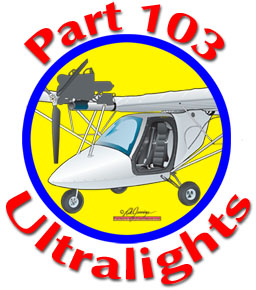
[UPDATE 1/18/22 — We made the 103 List even better with the “Model column now leading to info right here on ByDanJohnson.com, when available. Other article changes are shown in red text. —DJ]
Too many people believe this is a minor sector with “no fixed wing aircraft that qualify.” They’re wrong; we have 38 fixed wing producers alone. Some others among the general aviation pilot population thought that Part 103 ultralights had disappeared completely. They could not be more wrong.
Not only are plenty of Part 103 ultralights being produced, they come in many diverse shapes and plenty of them are being sold.
Clearly, it’s about time a list like this one got published to put the record straight!
Let’s Review…
Part 103 Ultralight Vehicles are a special category within the FAA regulations. How special? Here’s the important points:
- These most affordable aircraft need no FAA registration (no N-numbers are needed).
- Part 103 ultralights need no pilot certificate of any kind.
- Because no pilot certificate is needed, no aviation medical is required to fly Part 103.
- The manufacturer can fully build a 103 ultralight or sell in kit form.
- Operating a Part 103 ultralight follows a remarkably simple set of rules (one page, front and back)
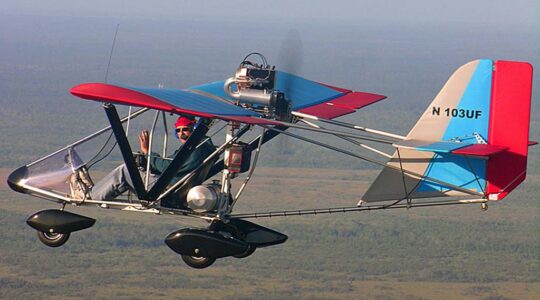
Many pilots believe Part 103 ultralights represent freedom in aviation like no other category. Some other aircraft types — LSA, motorgliders, hot-air balloons, some Experimental — also enjoy carve-outs from the FAA regulations for certified aircraft but 103 ultralights have a special regulation aimed specifically and solely at them.
The List
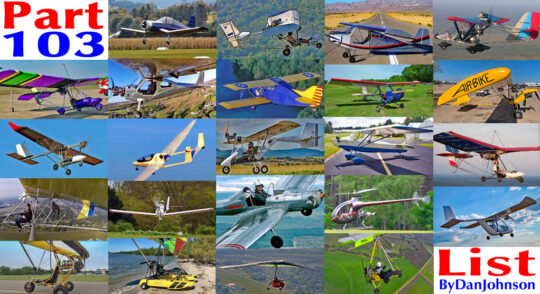
While aircraft in the Part 103 List meet this U.S. regulation, very similar (though not identical) programs are also offered in other countries, for example:
- 120 Kilogram Class — Germany, others (120 kilograms is 264.5 pounds; very similar)
- SSDR (Single Seat DeRegulated) and Sub-70 Kilogram — UK, others
- Microlight, and other 103-like regulations — France, various other countries
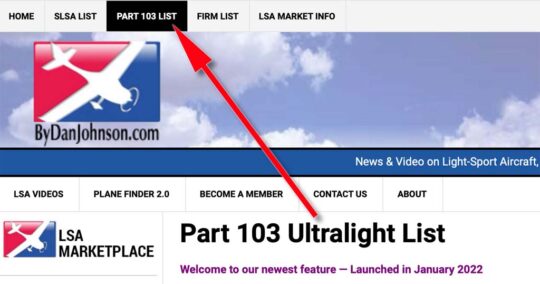
Using the Part 103 List — When you click on the link to the Part 103 List, you will see a long table of all 89 models. At the top you will see columns that you can organize to help you find what you want.
The columns titled “Brand,” “Model,” Type,” and “Origin” can be sorted alphabetically A-Z or Z-A. For example, if you want to see only Fixed Wing aircraft, click the small triangles near that column title and the list will reorganize as you’d expect.
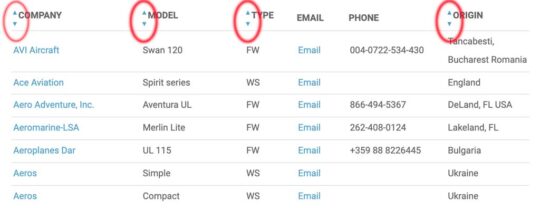
Gotta Have a Two Seater?
Part 103 is strictly limited to a single seat. Not everyone will be satisfied by that constraint. Many pilots, in order to gain acceptance from their spouse or generally to satisfy a desire for more capability, insist they need two seats.
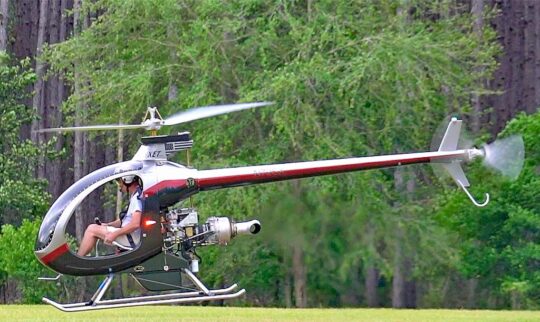
If that’s true, then why do many pilots insist on a second seat in their light aircraft?
Compared to the overall expense of creating a new aircraft, the cost of adding a second seat and the necessary structure, engine power, additional fuel, and larger wing area should not in theory add a tremendous amount to the cost of building such an airplane. However, perhaps it’s like the amplifier for your home theater. Once you decide you’ve got to have surround sound instead of just a couple of great speakers, you might have to upgrade everything in the system in order to make that all work. Airplanes are no different, of course.
I’ll give my opinion because I believe it is quite common; I’ve asked hundreds of pilots at airshows about this.
I enjoy flying solo because what I like best about flying is the great view from aloft, of flying over the countryside and observing things on the ground. Sometimes seeing what I want means banking steeply to have a closer look. I don’t do that when I’m concerned about another person in the cockpit with me. I find these flight movements more tolerable (even enjoyable) when I don’t have to worry about a person in a second seat.
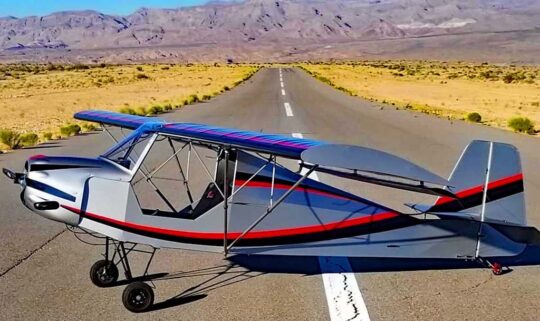
Flying with someone may be a great way to introduce someone to aviation or it might at least keep them from voting to tax your local airport out of existence.
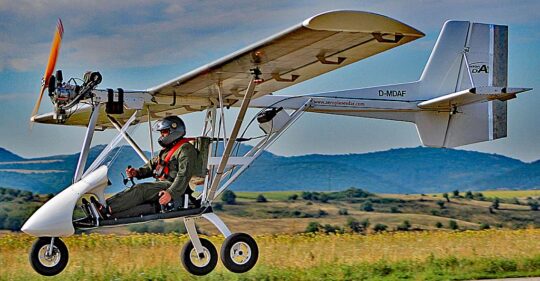
Of course, this creates some challenges to gain instruction appropriate to that Part 103 aircraft, so two seaters are necessary. When FAA created the Sport Pilot / Light-Sport Aircraft regulation, they scrapped existing “two-seat ultralights” for LSA. Many of the aircraft that followed are not good trainers for genuine 103 ultralights but some are, including Quicksilver 2S or M-Squared’s Breeze II or CGS Hawk II.
The Heart of Affordable Aviation
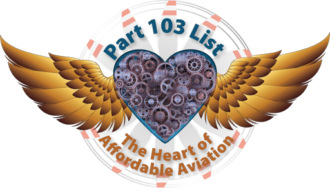
Since our SLSA List has consistently been one of the most popular features on ByDanJohnson.com, I hope you will enjoy the resource offered under the name Part 103 List. Please… go check it out and tell others.
Tail winds!


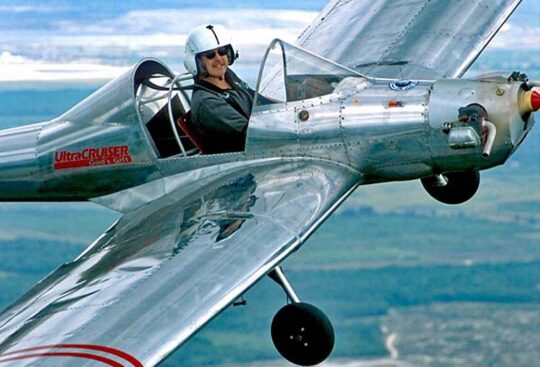 I enjoy flying solo because what I like best about flying is the great view from aloft, of flying over the countryside and observing things on the ground. Sometimes seeing what I want means banking steeply to have a closer look. I don’t do that when I’m concerned about another person in the cockpit with me. I find these flight movements more tolerable (even enjoyable) when I don’t have to worry about a person in a second seat.
I enjoy flying solo because what I like best about flying is the great view from aloft, of flying over the countryside and observing things on the ground. Sometimes seeing what I want means banking steeply to have a closer look. I don’t do that when I’m concerned about another person in the cockpit with me. I find these flight movements more tolerable (even enjoyable) when I don’t have to worry about a person in a second seat.
I have been looking all over the internet and have searched for an answer to this question without an answer.
Question: If a person, with a legitimate drivers license and has taken some dual pilot training and feels confident in taking off and landing an aircraft in calm and crosswind landings, has had navigation training in cross country flying, just get in a single seat Part 103 qualified aircraft and fly it at least around a qualified air space?
You qualified your question fairly well, but I will repeat that no pilot certificate is necessary to fly a complying Part 103 aircraft. However, I know of no supplier who would sell you a new one without assuring you had the skills to fly it. A private party just looking to unload unwanted property might, though.
Nonetheless… No medical is required. No pilot certificate is required. No N-numbers are required. That’s some of the beauty of Part 103.
As always thanks Dan. I have to ask though should the Top Rudder Just 103 remain on the list? I believe everyone that has followed that design would agree that project is dead. Would have loved to seen it come to life.
Ah, you have identified the ongoing challenge of this list: learning which companies may depart the business. However, based on my experience with the SLSA List and the Light-Sport Aircraft producer community, I’m inclined to leave an airplane up on the Part 103 List but to show it as “Not producing” (if that’s the case) because I have found that good designs often have a way of coming back to life under another brand.
Your point is well taken, though. I will follow up and see what I can find out about that particular aircraft.
Three cheers, Dan! I know what a Herculean task it’s been for you to compile this list. And keeping it current will be just as hard. Thank you for your service to all of us.
We have two more ultralights to add to your “Part 103 List.” We own and support the Gene Turner designed T-100D Mariah and the Frank Griffith designed CA-2 ultralight (formally sold by Frank and Hummel Aviation). We have had a lot of interest in both of these designs over the years and especially the last two years. We are also working on bringing back two ultralight and two experimental designs as well. Please add us to your new Part 103 list.
Thanks,
Ken Adams, Jr.
Adams Aeronautics Company, Inc.
http://www.adamsaero.com
(404) 219-7326
Thanks, Ken. After I examine your offerings, I will be pleased to add them to the Part 103 List. I appreciate you bringing your products to my attention.
Two aircraft (T-100D Mariah and CA-2) were added to the Part 103 List on 1/20/22.
When you think of the 103 weight limit you can understand why people are bringing suit against FAA for knowingly causing death and serious injury to 103 pilots desperate to fly even in kite-like planes .
In the interest of open dialogue, I am permitting this comment even while being doubtful about people “bringing suit against FAA.” The known Part 103 safety record does not suggest major problems with FAR 103’s parameters.
Thanks, Dan. Really like the idea of an all-in-one site.
It makes me sick that one of the best little light aircraft made meet all the requirements except its gross weight is a couple hundred pounds over the limits; easy to fly and over the years has proven itself over and over is the Cessna 150.
The Cessna 150 is more than just a couple hundred pounds over the Part 103 limit. In addition the Cessna has 2 seats, flies faster than 55 knots, and holds more than 5 gallons of fuel. So no, it doesn’t even really come close to meeting all the requirements for Part 103. The Cessna is in a completely different class of aircraft (“general aviation” to be specific).
I’m pretty sure Paul meant to compare the Cessna 150 to current day LSA, not Part 103. However, it would’ve been more appropriate with another article, say one about MOSAIC.
Much appreciated, Dan!